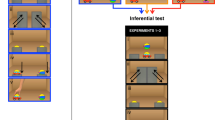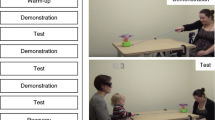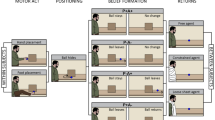Babies may opt for a simpler way to turn on a light after watching an adult do it.
Abstract
Here we show that if an adult demonstrates a new way to execute a task to a group of infants aged 14 months, the children will use this action to achieve the same goal only if they consider it to be the most rational alternative. Our results indicate that imitation of goal-directed action by preverbal infants is a selective, interpretative process, rather than a simple re-enactment of the means used by a demonstrator, as was previously thought1,2,3.
Similar content being viewed by others
Main
In Meltzoff's seminal study1, a group of 14-month-old subjects watched a demonstrator illuminate a light-box by leaning forwards and touching its top with her forehead1,2. One week later, two-thirds of them re-enacted this head action to achieve the same outcome, although none of the control group used it spontaneously. This was taken as evidence that infants separate the goal from the means, automatically imitating the means as demonstrated2. Such imitative learning is thought to be specific to humans, as primates do not imitate new strategies to achieve goals, relying instead on motor actions already in their repertoire (emulation)3. If this were also the case in infants, they would be expected to touch the box with their hands, rather than imitating the unfamiliar head action. (Meltzoff, however, did not report such hand actions1,2.)
The readiness of infants to re-enact the head action is surprising, given that 1-year-old babies can evaluate the rationality of the means in relation to the goal and the constraints of the situation4,5. When constraints change, these infants are able to work out the most effective action that the demonstrator should use to achieve the goal (the principle of rational action6,7). Infants would therefore be expected to re-enact an action only if it seemed to them to be the most effective means to achieve the goal (see also ref. 8).
So why did Meltzoff's subjects re-enact the head action, when they could just have touched the box with their hands? If infants noticed that the demonstrator declined to use her hands despite the fact that they were free, they may have inferred that the head action must offer some advantage in turning on the light. They therefore used the same action themselves in the same situation.
To test this idea, we replicated Meltzoff's study1 with one modification: in one condition, the subjects could see that the demonstrator's hands were occupied while she executed the head action (pretending to be cold, she had wrapped a blanket around herself which she held onto with both hands; 'hands occupied', Fig. 1a). After witnessing the same head action when the adult's hands were free (Fig. 1b), 69% of infants re-enacted the head action, replicating Meltzoff's results1. However, after watching the adult turn on the light with her head when her hands were occupied, the number of children who imitated the head action dropped significantly to only 21% (P < 0.02; Fig. 1c). It must therefore have seemed sensible to the infants that the demonstrator should use the head action when her hands were occupied — nevertheless, 79% of them chose not to imitate her because their own hands were free, presumably concluding that the head action was not the most rational.
a, b, Adult switching on the light by touching the lamp with her forehead in the hands-occupied condition (a, n = 14) or the hands-free condition (b, n = 13). c, Methods used by infants to switch on the light-box after watching the head action used by the demonstrator under these two conditions (left bar, adult had hands occupied; right bar, adult had hands free), recorded over a 20-s period. Blue, head action was re-enacted; green, only manual touch was used. Further details are available from the authors.
Whether they re-enacted the head action or not, all infants who watched the adult perform under both conditions still used the hand action. This suggests that 14-month-old infants are still subject to an automatic, emulation-like process whereby the memory of the effect (illumination by touch) activates the response that is most strongly associated with establishing contact (hand action). But the re-enactment of the head action, when inferred to be rational by the infant, indicates that imitation by 14-month-olds goes beyond emulation. We conclude that the early imitation of goal-directed actions is a selective, inferential process that involves evaluation of the rationality of the means in relation to the constraints of the situation.
References
Meltzoff, A. N. Dev. Psychol. 24, 470–476 (1988).
Meltzoff, A. N. J. Exp. Child Psychol. 59, 497–515 (1995).
Tomasello, M. The Cultural Origins of Human Cognition (Harvard Univ. Press, Cambridge, Massachusetts, 1999).
Gergely, G. et al. Cognition 56, 165–193 (1995).
Csibra, G. et al. Cognition 72, 237–267 (1999).
Gergely, G. & Csibra, G. Cognition 63, 227–233 (1997).
Csibra, G. & Gergely, G. Dev. Sci. 1, 255–259 (1998).
Bekkering, H., Wohlschlager, A. & Gattis, M. Q. J. Exp. Psychol. Human Exp. Psych. 53A, 153–164 (2000).
Author information
Authors and Affiliations
Corresponding author
Rights and permissions
About this article
Cite this article
Gergely, G., Bekkering, H. & Király, I. Rational imitation in preverbal infants. Nature 415, 755 (2002). https://doi.org/10.1038/415755a
Issue Date:
DOI: https://doi.org/10.1038/415755a
This article is cited by
-
Infants’ Prediction of Humanoid Robot’s Goal-Directed Action
International Journal of Social Robotics (2023)
-
Foundations of theory of mind and its development in early childhood
Nature Reviews Psychology (2022)
-
Encultured knowing: knowledge transmission and varieties of cultural learning
Synthese (2022)
Comments
By submitting a comment you agree to abide by our Terms and Community Guidelines. If you find something abusive or that does not comply with our terms or guidelines please flag it as inappropriate.




